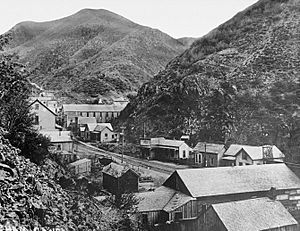Bingham Canyon, Utah facts for kids
Quick facts for kids
Bingham Canyon
|
|
|---|---|

Bingham Canyon in 1914
|
|
| Country | United States |
| State | Utah |
| County | Salt Lake |
| Founded | 1863 |
| Incorporated | February 29, 1904 |
| Became a city | May 23, 1938 |
| Abandoned | 1972 |
| Named for | Thomas and Sanford Bingham |
| Elevation | 5,938 ft (1,810 m) |
| GNIS feature ID | 1425580 |
Bingham Canyon was a small city that used to be in Salt Lake County, Utah, in the United States. It was located in a narrow canyon within the Oquirrh Mountains. In the early 1900s, Bingham Canyon grew very quickly. This happened because a lot of valuable copper was found there. At its busiest time, about 15,000 people lived in the city.
However, the very thing that made the town successful also led to its end. By the middle of the 1900s, the huge open-pit Bingham Canyon Mine started to expand. It grew so large that it began to take over the land where the town was built. This forced people to move away. By the 1970s, almost all of Bingham Canyon was gone, swallowed by the mine. The few people who were left decided to officially close the town. Today, you won't find any trace of Bingham Canyon.
Contents
History of Bingham Canyon
The area known as Bingham Canyon got its name from two brothers, Thomas and Sanford Bingham. They were the first settlers to arrive in the canyon in 1848. At first, people used the land for raising animals and cutting down trees. But in 1863, something big changed. Gold and silver were discovered in the canyon.
Mining in Bingham Canyon really took off after 1873. That's when the Bingham Canyon and Camp Floyd Rail Road built a train line to the canyon. As the area grew, miners started focusing on the high-quality copper found there. The town of Bingham grew right along with the mines. It spread out along the narrow, steep floor of the canyon, just below the mining areas.
The Mining Boom
The Bingham Canyon mines had their biggest boom in the early 1900s. Smaller mines in the area joined together under larger companies. A very important event happened in 1903. Daniel C. Jackling created the Utah Copper Company. This company started using a new method called "surface mining" at Bingham Canyon. This meant digging a huge open pit from the top down.
The Utah Copper Company's mine did very well. This brought many new people to the canyon. The town of Bingham Canyon officially became a city on February 29, 1904.
By the 1920s, Bingham Canyon was at its busiest. It had about 15,000 residents. The city stretched for about seven miles along the single, winding road in the steep canyon.
Diverse Neighborhoods
Like many mining towns in the American West, Bingham Canyon had many different neighborhoods. Each often had people from specific ethnic groups. For example, many people from Scandinavia lived in the Carr Fork area. People from southern and eastern Europe gathered in Highland Boy. This was in another branch of the canyon, higher up.
As the main street in the canyon grew, the upper part of the town became known as Copperfield. Bingham itself attracted people from Britain, France, Ireland, Puerto Rico, Mexico, and other places. Many other small communities also existed. Most were named after the mines nearby. Some of the first communities to be taken over by the mine were Commercial, Boston Con, and "the Niagara." Other areas included Galena, Old Jordan, and Silver Shield.
Some neighborhood names were very colorful. These included Terrace Heights, Dinkeyville, Jap Camp, and Greek Camp. These were all parts of Copperfield. The Frisco, Yampa, Phoenix, and Apex were in Carr Fork, along with Highland Boy. Further down the canyon were Markham, Freeman, and Frog Town.
The Town Shrinks
The importance of Bingham Canyon started to decline as early as the 1920s. The canyon's difficult landscape made it hard to build more homes. It also made the town vulnerable to dangers like fires and avalanches. In 1926, a tragic avalanche destroyed a mining camp in the area, causing many deaths.
The first step to reduce the number of people living in the canyon happened in 1926. The Utah Copper Company built a new town called Copperton. This town was on the flat land east of the canyon. It was a nice community, and the company used a lot of copper products to build the houses. Low rent encouraged company workers to live there. In 1956, Kennecott, the company that owned the mines, sold these homes to employees.
More machines were used at the mine, which meant fewer jobs were available. This also caused Bingham Canyon's population to shrink.
The Mine Takes Over
By the 1930s, it became clear that the biggest threat to Bingham Canyon was the mine itself. The mine's huge open pit kept growing. It began to take over the land where miners' homes and neighborhoods once stood. The mine continued to expand throughout the middle of the 1900s. By 1971, very little of the town was left.
That November, the 31 people still living in Bingham Canyon voted. They decided to officially close the town. The last buildings in Bingham were torn down in 1972. Today, most of the land where Bingham Canyon once stood has been consumed by the Bingham Canyon Mine.
Notable People
- Keith Conners, a psychologist known for setting the first standards for diagnosing attention deficit hyperactivity disorder (ADHD).
- David Daniel Marriott, a former U.S. Representative.
- John Saltas, who started the alternative newspaper Salt Lake City Weekly.
Images for kids






